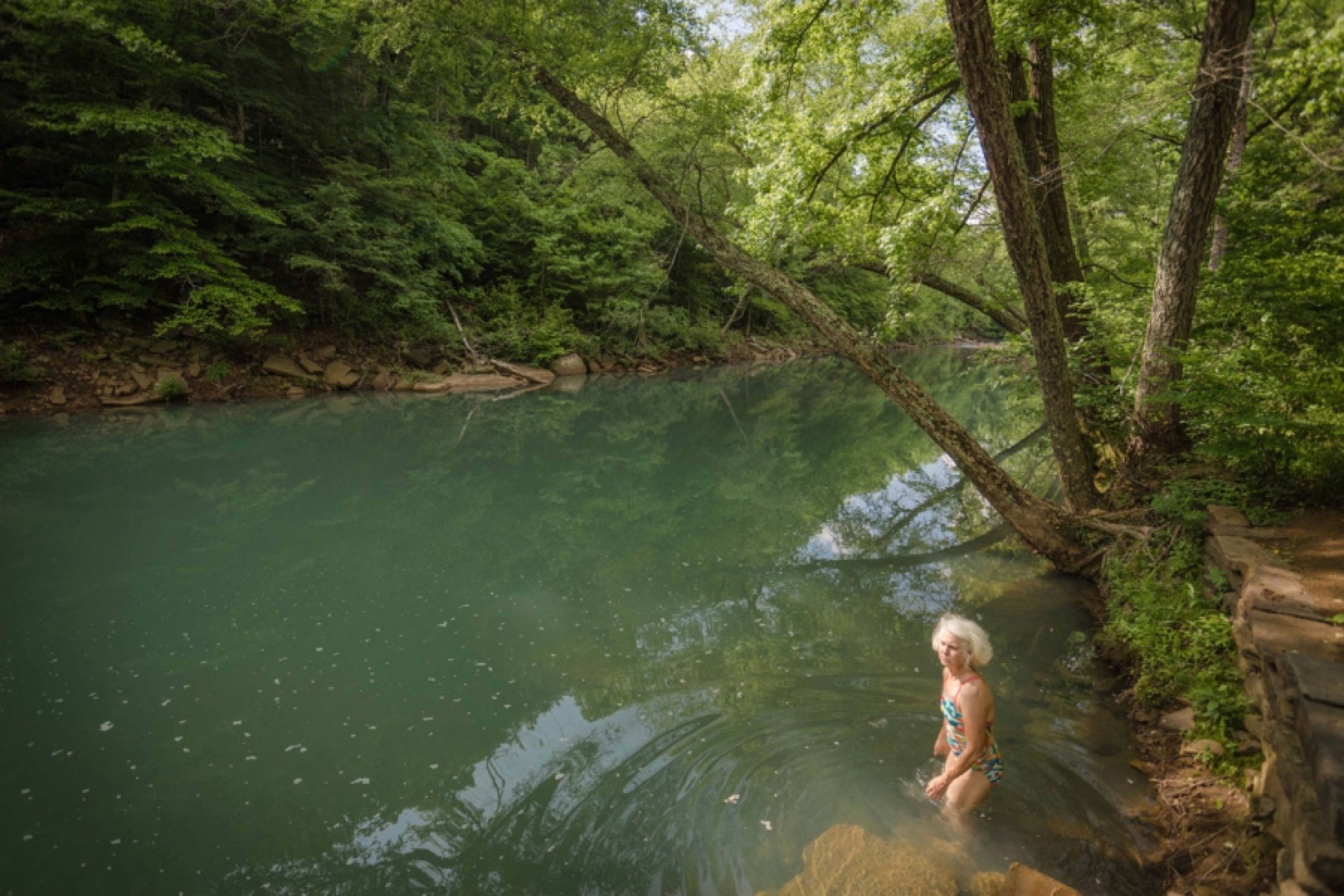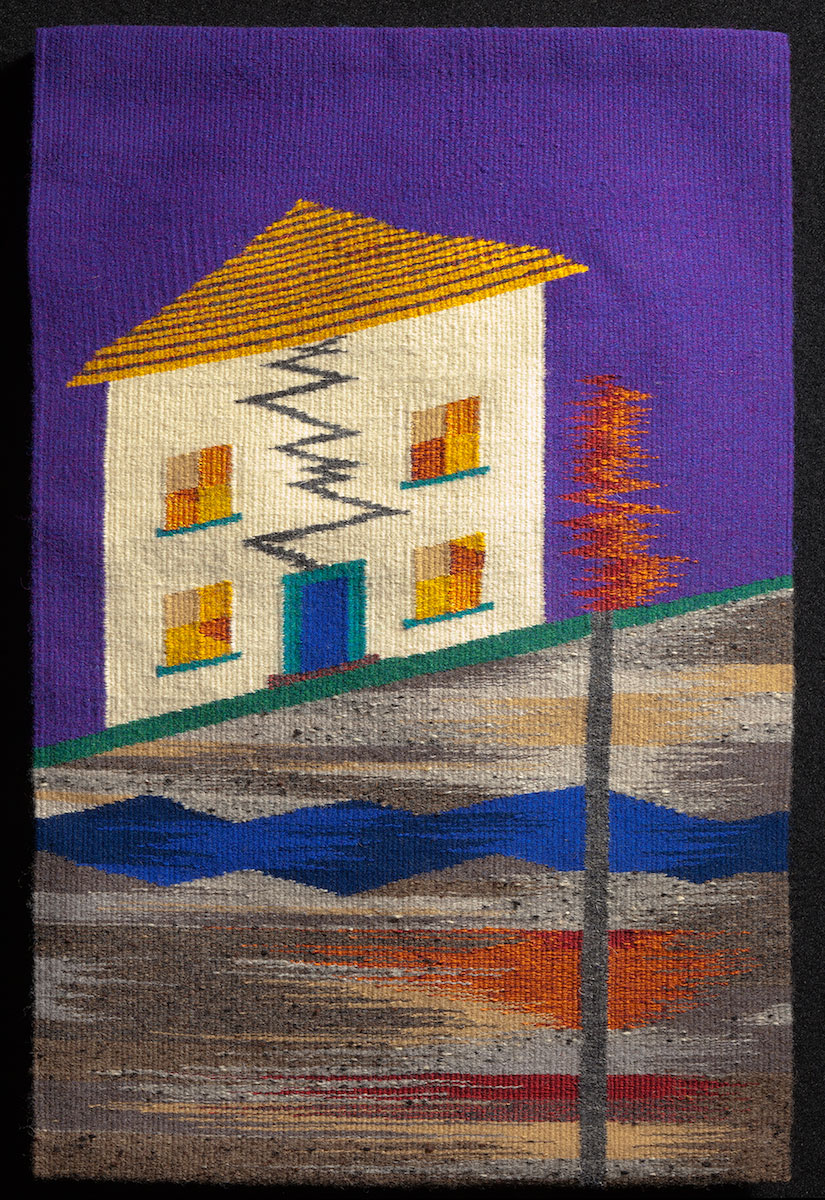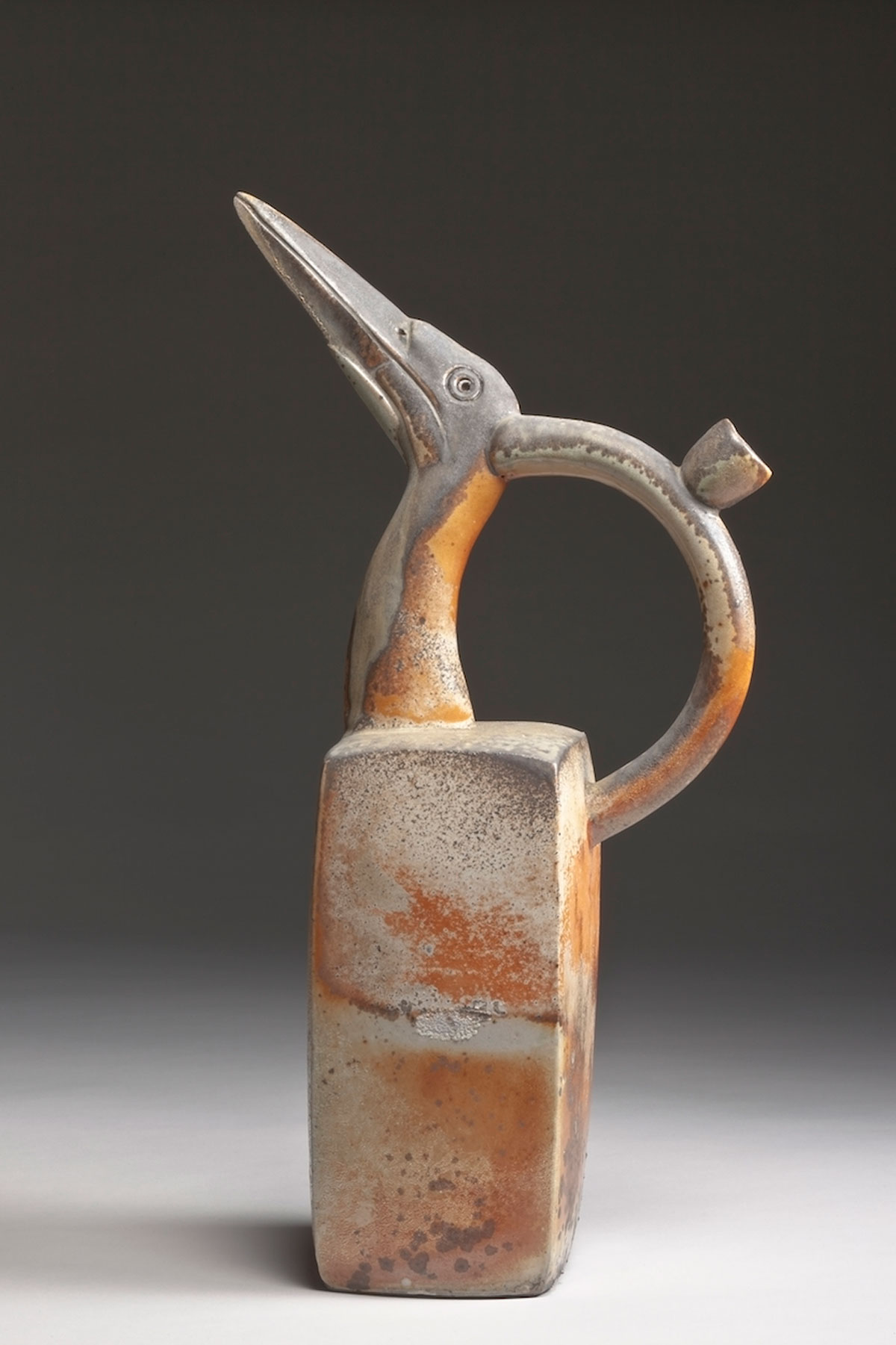
Louise Halsey, the author's mother, at Little Mulberry Creek. Photo by Rodrigo Jardón
NOT YET LOST
By Alice Driver
As a child, I recognized snakes by the way they moved in the water. Moccasins glide in a strong S-shape, and non-poisonous snakes are lithe when they swim. If I got too close to a moccasin, it would coil tight and rise in fluid oily blackness, head ready to strike. I was born at home near the banks of the mineral-blue Little Mulberry River in the Ozark Mountains. Growing up, I felt most at ease in those waters.
In June of 1978, my dad, Stephen Driver, and his three brothers bought eighty acres of land bordering the Ozark National Forest in northwest Arkansas, along the Little Mulberry. They moved there from Michigan, bringing their wives, girlfriends, and children—ten people in all, including my mom, Louise Halsey. My mom, a weaver, had met my dad, a potter, at an arts conference in Georgia, when they were lean and young, questioning if they would ever find anyone who loved them. In college, my mom, who started to get white hair at age eighteen and never dyed it, put a sign on the ceiling of her dorm room that read COMMUNE. She had grown up in a house in which art students and artists like Maurice Sendak were constantly passing through. She thought group living made more sense than single housing.
In their early years on the property, my parents lived in a tent near the river. They walked around barefoot at night, blissfully unaware of the presence of vipers. The men got along well enough to sit side by side in the two-seater outhouse while reading the newspaper in the morning. They worked odd jobs, saved money to buy lumber and other building materials, learned how to wire their houses for electricity, installed windows. The women worked beside them, chopping wood and tilling gardens, and eventually having children in waves—the girls, including me, were all born in 1981, and then the boys in 1983. My parents invested every bit of money they had in windows, doors, and nails. Once the first building on the property was erected, everyone migrated from tents to a tin shed. When they built houses, the shed became my dad’s pottery studio.
My three cousins, my brother Ian, and I formed a wandering tribe. We collected crawdads, jumped off the rope swing, and ground colored stones into a fine power that we mixed with water and painted on our bodies. When we were little, we often swam in the rain, because then the water seemed warmer, like a blanket we could wrap around ourselves. Time was an expanse, a circular flow of woods and stars. There were few distractions—Clarksville, the nearest town, was thirty-two winding miles up the mountain road, and we had no computer. The telephone was an eight-party line. When my grandma Eleanor died, she left us her old TV, but only one channel came in. I knew more about flowers than I knew about pop culture. I could identify hollyhocks, bachelor buttons, tiger lilies, celosia. On hot summer days, I would sprint the quarter-mile from our house to the creek, occasionally running into a fat rat snake sunning itself near the barn or a copperhead out in search of mice and lizards.
As a child, my mother—the daughter of two abstract painters—made potholders by the thousands. In high school, she embroidered her high-top shoes and made a dress entirely out of bubblegum wrappers. She loved living in a tent in the Ozarks, bathing in the creek, gardening, and being around her family—she thought it was romantic. And there was a romance in living off the land, in feeling that my whole childhood could be mapped out on our own piece of territory.
Over the past decade, my parents have made art that reflects the changes they’ve seen in the land and water. In 2011, the U.S. Forest Service and Bureau of Land Management issued a report stating that it would allow hydraulic fracturing, known as fracking, in the area around my parents’ house. By injecting water and chemicals deep into the earth, fracking pushes gas to the surface. However, the wastewater and the chemicals then have to be disposed of, and they often end up in groundwater. The process itself can later cause small earthquakes. Fracking is not my parents’ only concern. Even just a few miles away from our peaceful mountain view, neighbors have logged whole sections of the forest. Every time I return home, the forest has more bald patches—red earth that bleeds water, flooding the creek and road during storms.
In response to these changes, my mom wove a series of tapestries of the Little Mulberry, the blue-green waters that she feared would be polluted. Her work was influenced by Glenn Albrecht, an Australian philosopher who coined the term solastalgia, a combination of the Latin word solacium (comfort) and the Greek root –algia (pain), which he defined as “the pain experienced when there is recognition that the place where one resides and that one loves is under immediate assault . . . a form of homesickness one gets when one is still at ‘home.’”
 “Frackhouse,” by Louise Halsey. Photo by George Chambers
“Frackhouse,” by Louise Halsey. Photo by George Chambers
My mother’s weaving “Frackhouse” features a house with a fractured zigzag running through it, splitting the home in half, representing the small earthquakes that are caused by fracking. Arkansans who live within six kilometers of fracking wells experienced more than 1,200 earthquakes. Though considered “minor,” the earthquakes caused damage to buildings and scared residents. The weaving shows the layers of earth below the house, and a cobalt blue line that represents the aquifer. Also evident is a bore hole into which chemicals have been pumped to pressure the oil out of the earth. The chemicals are depicted with red and orange wool, and they are shown leaking into the layers of earth and the aquifer.
Environmental preoccupations have made their way into my dad’s work, as well. In 2013, he completed a large-scale sculpture installation for the Bernice Garden in Little Rock. The sculpture consists of a wall that is slate on one side and ceramic tile on the other. Different species of local fish, made out of clay, are swimming through the wall. For him, the work symbolizes fish trying to escape our world and flee to another where their habitat has not been polluted by humans. My dad also made a series of animal effigy pieces such as “Heron asks God why frogs are no longer on the Menu,” which refers directly to the idea to extinction and the loss of food sources for certain animals.
 “Heron Asks God Why Frogs Are No Longer On The Menu,” by Stephen Driver. Wood fired porcelain. Photo by George Chambers
“Heron Asks God Why Frogs Are No Longer On The Menu,” by Stephen Driver. Wood fired porcelain. Photo by George Chambers
I am moved by my parents’ art, by their commitment to each other and to the land. I have witnessed their everyday struggles to create, to make a living, to raise children, and to form a community. Our family, friends, and neighbors have quietly supported their work for decades, and have been involved in organizing against fracking in Arkansas.
Now I live in Washington, D.C.—the last time I lived at home was in 2011, when I was finishing my first book. For the first sixteen years of my life, my family rarely left Arkansas because money was scarce. After I went to college, I became obsessed with travel and languages and the feeling that the world was an expanse that I must explore. My adult life has been defined by these tensions, by love for my homeland versus hunger for the foreign and my need to constantly expand my range of territory. I felt a connection to my homeland, but I realized I could not live there when I was writing my book; after a few weeks, I found the isolation suffocating.
I last visited Arkansas over Thanksgiving. While I was home, my dad talked about his ceramic fish while standing over the stove, pouring coconut milk into a Thai curry made with sweet potatoes from the garden. When he talks about his work, he is often angry. He described a fish sculpture he wanted to make, which would balance a fortune cookie on its nose: “When people open up the fortune cookie, it will say We’re fucked!”
 “Waiter Fish Series # 4 - Climate Change Fortune Cookies,” by Stephen Driver. Wood fired stoneware, Melmac, and fortune cookies. Photo by George Chambers
“Waiter Fish Series # 4 - Climate Change Fortune Cookies,” by Stephen Driver. Wood fired stoneware, Melmac, and fortune cookies. Photo by George Chambers
My parents have long worked to have power over their own lives—to prepare for climate change, to take control of their own little piece of land and make it sustainable. My dad jokes that he wants to make all his vices by hand. Last summer he decided he was going to make a year’s supply of jam for his morning toast. (He also makes his own beer.) He and my mom buy all their meat from our neighbor. Their house is powered by solar panels, and they store water in three 1,100-gallon black tubs. Every time I return home, my parents are a bit more independent. I see their art as an act of defiance and one of mourning.
Only my Aunt Karen remains in a house across the street from my parents, although several aunts, uncles, and cousins live an hour north in Fayetteville. The rest of the family has dispersed across the United States in search of educational opportunities, jobs, and love. The communal experiment that the brothers undertook in economically depressed rural Arkansas eventually fell apart. The brothers remain close, like boxers, constantly circling each other, held together but in tension by their common history.
I feel like I am free diving when I return to Arkansas, going down to a place where I lose all sense of what is up and what is down. Going home is like diving into the creek in winter—a shock to the system because I am suddenly unplugged. It can be disorienting, and it always takes a moment to adjust to the quiet and the lack of constant connection: there is still no cell phone reception, the internet is limited, and electricity goes out during storms. There is no light pollution, so nights are the kind of dark that eats up everything, which can be both frightening and beautiful.
I talk to my parents almost every day when I am not at home, because I know how lonely it can be out there. Although I know they love the land, I worry about them. They are so isolated.
On my first night home last November, I woke up in a cocoon of darkness to the sound of a faraway cry: the sound of coyotes yelping. When I fell back asleep, I dreamt that Ernesto, my parent’s dog, was on top of me, and he wouldn’t get off. I woke up covered in sweat, yearning for the sunrise.
When Solastalgia, my mom’s exhibition, opened in 2013, I attended the exhibit, but I don’t remember thinking about the meaning of the word: comfort, pain. It is only now that I realize that the term also describes my parents. They fear that they will lose what they love most—that the piece of land they bought thirty-eight years ago, which allowed them to chart the course of their lives, grow food, and make art, is slowly being destroyed by forces beyond their control. They are angry about this loss, and the only way they know how to express their anger and fear is through art. But in working as stewards of the land and slowly laying down the framework to deal with changes that may come, they are also hopeful.
The last time I was home, my mom and I walked down to the creek, stripped off our clothes, and dove into the water. Her pale freckled skin was visible next to mine below the still clear waters of my birthplace. Yet again, we let the river embrace us. We both knew what it felt like to mourn something we had not yet lost.
For more web features from the OA, subscribe to our weekly newsletter.


